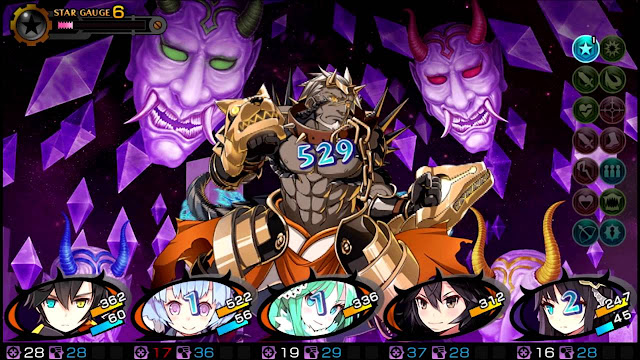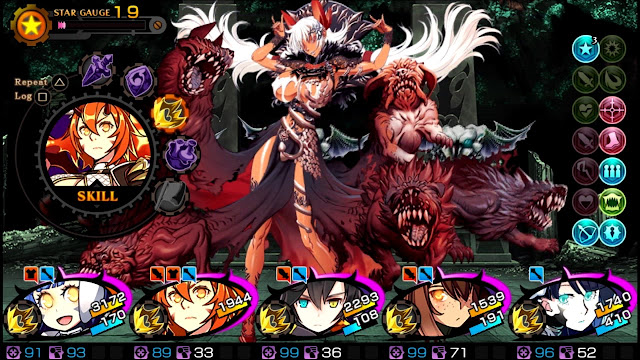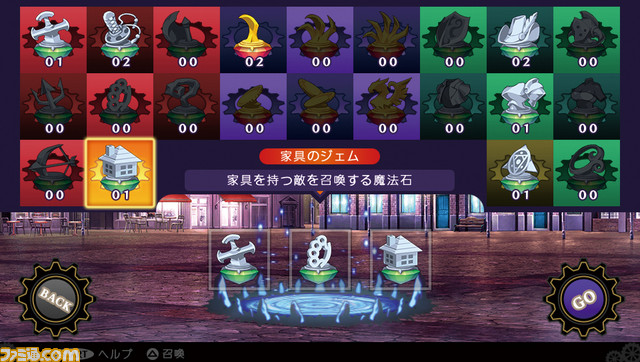Interview by Matt S.
The dungeon crawler genre has been around since the very foundations of the RPG. Most of us older people have fond memories of playing through the Wizardry and Might & Magic games of the ‘80s and ‘90s, and indeed the early dungeon crawlers featured prominently in our recent best 100 RPGs and JRPGs of all time list.
Related reading: Read our review of the first Demon Gaze here.
It’s also a genre that has remained stubbornly traditional. Where the general RPG has changed mightily from the first Final Fantasy to the modern JRPG, and the early Dungeons & Dragons games to the likes of Skyrim, if you were to pick up a modern dungeon crawler, such as Demon Gaze, the changes from those early Wizardry titles are far more subtle.
And yet there is an evolution in them. Fans might like their crawlers fairly traditional in terms of mechanics and design (I know I do), but developers want to reach out to new audiences, and that was explicitly the intent of Demon Gaze. I liked that, too. The game’s upcoming sequel, Demon Gaze II, is looking to do the same thing, according to Kouno Juntaro, Producer of Development Division at Kadokawa Games.
“Dungeon RPGs as a genre are very traditional they appeal to one segment within the overall market of game playing people, and they’re kind of set in their ways,” Kouno said. “So the goal with the original Demon Gaze was to broaden that fanbase to reach people that to that point had not wanted to play DRPGs. One way we thought to do that was through the use of colour and art.”
Demon Gaze is a very memorable dungeon crawler on the PlayStation Vita – one of the most memorable games of all on the console – and the art that Kouno is referring to is a significant reason why. Boss battles, in particular, are spectacular in the way that they fill the screen with rich, colourful, detailed design and animation.
“I’m glad you noticed and remembered the boss battles from the first Demon Gaze,” Ataka Motoya, General Manager of Development Department, and Director at Experience Inc, and one of the most experienced veterans in dungeon crawler development in Japan, said to me. “The point of Demon Gaze is that you’re collecting demons, and adding them to your party. We know that’s not something new, so we wanted to make sure that what we were releasing was nothing less than anything else in the market. Making the boss battles, and their designs, memorable was important to us.”
Demon Gaze: Now in HD
Part of what makes the upcoming Demon Gaze II so exciting is that it is being released on PlayStation 4, as well as PlayStation Vita. On the PlayStation 4, that art, and those incredible battle characters and animations, will look even more impressive on the big screen.
“The Vita definitely offers something for DRPGS,” Ataka said. “Usually DRPGS offer a lot of content, and a lot of extra content beyond the main story, so that idea of anywhere anytime makes a great platform for the PlayStation Vita.
“However, due to the limitation of the Vita as hardware there were limitations in terms of what we could do in terms of backgrounds and finer details of the dungeons themselves. The PS4 version, in addition to getting the overall HD gloss to it, gives players a greater ability to see fine details. For example, radios are a key theme in the game, and there are little radios placed around the dungeons, as part of the thematic design. You’re probably not going to really notice those on the Vita, but on the PS4 they are far more clear.”
Demon Gaze II also benefits from being the first Japanese dungeon crawler to be released on the PlayStation 4 in the west. As a console with a far deeper mainstream reach than the PlayStation Vita, it also means that the development team have the opportunity to reach those less hardcore dungeon crawler players, and so one of the key goals of Demon Gaze II was to address some balance issues that prevented a number of players of really getting into the original.
“In Japan, about 30 per cent of players cleared Demon Gaze, and we wanted to flip that so only 30 per cent of players didn’t clear the sequel. In the end it sat around 50 per cent, so we considered that this was a success overall,” Ataka said.
“In the first Demon Gaze there was dungeon later on, that about 50 per cent of players gave up when they reached it,” Kouno added. “Of course, as you progress through the game it needs to become more difficult. However, the goal being for the series to reach a broader group of people we decided to look at that another time when making Demon Gaze II’s difficulty.
“This time, rather than again having a huge difficulty spike with that one dungeon, we decided to make the difficulty curve be more gradual, with the goal being for more people to finish the game. At the same time, we knew there was a big group of people who really wanted to get in deep with the game’s mechanics. The hardcore DRPG fan wants it difficult. That’s why we implemented a massive optional dungeon set after the events of the main game that really let us let loose for the fans.”
Telling stories with dungeon crawlers
The other challenge for dungeon crawlers in reaching a wider audience is that they don’t tend to be story focused. That’s not to say they didn’t offer a narrative, but rather, the early dungeon crawlers would barely offer an introduction to the setting, instead relying on players to engage their imaginations as they explored the labyrinths to create a narrative through the experience of the adventure itself.
That initial design stuck for the genre, and it became part of the pacing of the genre itself; get players into the dungeons as quickly as possible and let the mapping and monsters delight the imagination. But the original Demon Gaze was different; it was a dungeon crawler with a genuine focus on storytelling. Where other modern dungeon crawlers might have more by way of cut scenes and dialogue, there are few that had memorable characters, or scenes outside of the dungeons themselves. Demon Gaze was one of the few.
“From personal experience I played Wizardry games from when I was young, and really liked them, and I was able to use my imagination to fill in the blanks for what this grand tale could possibly be,” Kouno said. “Nowadays players are used to games that have a narrative focus and have a lot by way of movies and CG cutscenes, and if you’re going to appeal to people outside of the most niche crawler fans you need to meet those expectations. Not everybody is able to, or willing to, fill in the blanks to a barebones narrative. So in order to compensate for that and ensure everyone was able to follow along, the narrative was an important part to put in there.
“That said we didn’t want to over-tell the narrative, either. Though it’s a strong focus there’s still enough of the areas within the story that are left untold to allow players to fill in the blanks for themselves.”
The consequence for dungeon crawlers that do try and have a narrative focus is that the additional “down time” in dialogue sequences or spending time in “town” can disrupt the rhythms that traditional dungeon crawler fans tend to enjoy. That in turn can have those of us that did grow up with the genre reaching for our PCs and GOG collection of Might & Magic and Wizardry.
So it’s a testament to the quality and pacing of Demon Gaze that it managed to balance the two. I asked Ataka if there was any particular process that went into finding the balance, and he said it was simply a matter of experience in having been working on dungeon crawlers through most of his career.
“I’ve been working with DRPGS for a long time; from the early days when Wizardry became a Japanese license,” he said. “Some time in, there was a game we worked on called Wizardry Xth, and it was the first time they deliberately thought about the ‘casual’ user for the first time, which we defined as the people who like video games but not any one kind in particular. We thought about how to appeal to those people too, and we realised the answer was to have a good story that gave players a world they could get into. Ever since then we’ve been trying to do that with our games.
“Demon Gaze, was the culmination of all that know-how and experience. There’s no science in making sure that both sides are well balanced and there’s nothing that hurts the flow of the game because of an overabundance of story – or any other element – it’s just something that we’ve learned how to do effectively over the years.
“So we take it as praise when we hear that people were able to enjoy the game’s story without feeling like they were missing out on the dungeon crawling.”
Remaining firmly Japanese
Everyone knows there’s a fundamental difference between the RPG and JPRG. The Witcher 3 and Dragon Quest XI are so entirely different in tone, storytelling, design and philosophy that’s it’s impossible to consider that they belong to the same genre.
The same can be said about dungeon crawlers developed in the west, when compared to those developed in Japan. Demon Gaze isn’t just a different development team to something like Legend of Grimrock; it’s an entirely different way of looking at how games are made, at every level.
We’re seeing attempts to rationalise genres so that they “work” for all kinds of RPG fans. Final Fantasy XV cribs more than a few ideas from western open world games. Dark Souls or Bloodbourne are nominally JRPGs, but they’re structured differently to be a mesh of western and eastern design elements.
Experience Inc. is the real flag-carrier for the Japanese dungeon crawler in the modern market, having produced not just Demon Gaze, but also Stranger of Sword City, Ray Gigant, and others. Was there any plans to bring together the western and Japanese approach to the dungeon crawler?
Certainly not with the Demon Gaze IP, Kouno said. “The idea of survival is core to western dungeon crawlers, where you’re stuck in one place and just surviving is seen as an achievement. That has its own charm and I love Legend of Grimrock. But it is important that they maintain the Wizardry tradition in Demon Gaze. If we ever wanted to make a game that’s like a western DRPG we’d probably make a western DRPG, rather than try and fuse the two styles of DRPG together.”
“One thing that was really well received about Demon Gaze is that the tempo was really good,” Ataka said. “It felt good to play to get into the dungeon crawling. When you switch to a survival style you’d change that, and you might lose what people loved about it in the first place.”
So, as long as Demon Gaze is going as a franchise, it looks like we can expect each game to be an iteration of the original. And that’s a very good thing indeed.
– Matt S.
Editor-in-Chief
Find me on Twitter: @digitallydownld
 |
| Please Support Me On Patreon!
|













